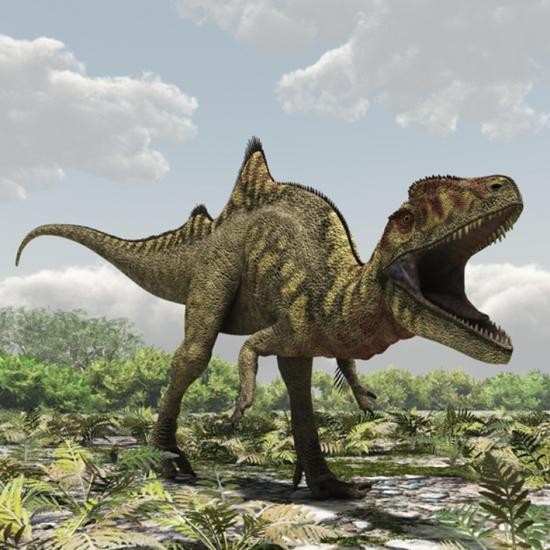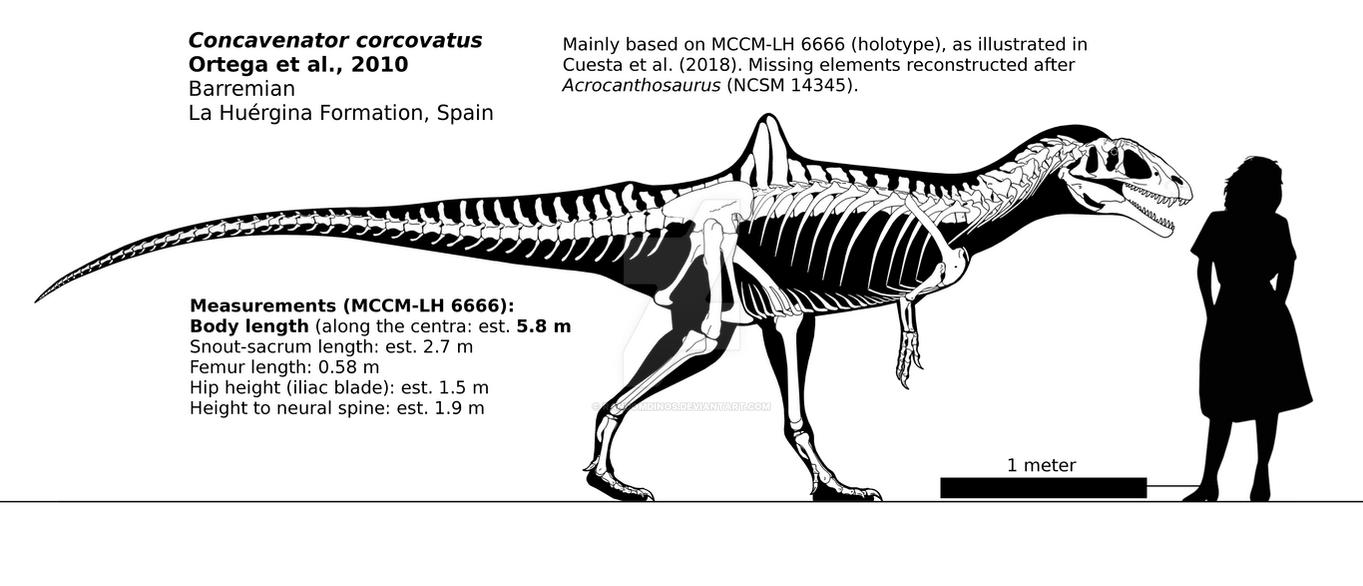Post by dinosauria101 on Mar 5, 2019 21:52:24 GMT 5
Concavenator corcovatus

Fossil range: Early Cretaceous, 130 Ma
Scientific classification
Kingdom: Animalia
Phylum: Chordata
Class: Reptilia
Superorder: Dinosauria
Order: Saurischia
Suborder: Theropoda
Family: Carcharodontosauridae
Genus: Concavenator
Species: Concavenator corcovatus
Concavenator was a genus of theropod dinosaur that lived approximately 130 million years ago during the early Cretaceous period. The type species is C. corcovatus; Concavenator corcovatus means "hump backed predator from Cuenca". The fossil was discovered in Spain by paleontologists José Luis Sanz, Francisco Ortega and Fernando Escaso from the Autonomous University of Madrid and the National University of Distance Learning.
Description
Discovered via a finely preserved, nearly complete skeleton found in central Spain, the 20-foot-long (6-meter-long) Concavenator corcovatus—"the hunchback hunter from Cuenca"—had two raised backbones, each 1.3 feet (40 centimeters) taller than the dinosaurs' other vertebrae. The function of such crests is currently unknown. Paleontologist Roger Benson from Cambridge University speculated that one possibility is that "it is analogous to head-crests used in visual displays", but the Spanish scientists who discovered it noted it could also be a thermal regulator. It was also previously speculated that Concavenator had feathered forearms. However, in 2018 Cuesta Fidalgo published her doctorate thesis on the anatomy of Concavenator which argued that the ulna was preserved in lateral view, meaning that the ulnar bumps were positioned posterolaterally rather than anterolaterally as Cau and Mortimer claimed. Cuesta Fidalgo noted that the proximal part of the ulna is affected by fracturing and abrasion, and certain features would have shifted compared to their position in the bone when the animal was alive. For example, in the fossil, the lateral process of the ulna is positioned further posteriorly than the ulnar bumps. In Allosaurus and Acrocanthosaurus, the lateral process is on the lateral (rather than posterior) part of the bone, which would seem to support the ulnar bumps being anterolateral in position if the lateral process was truly preserved in lateral orientation in Concavenator. However, Cuesta Fidalgo described how the lateral process's was distorted posteriorly compared to the bumps, and was not valid evidence for the claim that the ulna had shifted into anterior view. The ulna's distortion (as well as genus-specific proportions) means that precise comparisons to Allosaurus and Acrocanthosaurus would be misleading.[10] As Cuesta Fidalgo and her colleages explained in 2015, the ulnar bumps could not be an intermuscular line if the bone is preserved in lateral view.[6] In addition, Matt Martyniuk has noted that the hypothesis that wing feathers evolved as early as allosauroids is not as unlikely as Cau claimed. Cau used examples of wingless feathered dinosaurs such as Dilong and compsognathids to support the idea that wing feathers only involved within Paraves. However, Martyniuk noted that their absence in Dilong and compsognathids may have been an independent reversion correlated with the reduced forelimbs in those lineages, similar to the case with many modern flightless birds.
TL:DR: The ''quill knobs'' on Concavenator's ulna were actually something else, likely muscle attachments.

Fossil range: Early Cretaceous, 130 Ma
Scientific classification
Kingdom: Animalia
Phylum: Chordata
Class: Reptilia
Superorder: Dinosauria
Order: Saurischia
Suborder: Theropoda
Family: Carcharodontosauridae
Genus: Concavenator
Species: Concavenator corcovatus
Concavenator was a genus of theropod dinosaur that lived approximately 130 million years ago during the early Cretaceous period. The type species is C. corcovatus; Concavenator corcovatus means "hump backed predator from Cuenca". The fossil was discovered in Spain by paleontologists José Luis Sanz, Francisco Ortega and Fernando Escaso from the Autonomous University of Madrid and the National University of Distance Learning.
Description
Discovered via a finely preserved, nearly complete skeleton found in central Spain, the 20-foot-long (6-meter-long) Concavenator corcovatus—"the hunchback hunter from Cuenca"—had two raised backbones, each 1.3 feet (40 centimeters) taller than the dinosaurs' other vertebrae. The function of such crests is currently unknown. Paleontologist Roger Benson from Cambridge University speculated that one possibility is that "it is analogous to head-crests used in visual displays", but the Spanish scientists who discovered it noted it could also be a thermal regulator. It was also previously speculated that Concavenator had feathered forearms. However, in 2018 Cuesta Fidalgo published her doctorate thesis on the anatomy of Concavenator which argued that the ulna was preserved in lateral view, meaning that the ulnar bumps were positioned posterolaterally rather than anterolaterally as Cau and Mortimer claimed. Cuesta Fidalgo noted that the proximal part of the ulna is affected by fracturing and abrasion, and certain features would have shifted compared to their position in the bone when the animal was alive. For example, in the fossil, the lateral process of the ulna is positioned further posteriorly than the ulnar bumps. In Allosaurus and Acrocanthosaurus, the lateral process is on the lateral (rather than posterior) part of the bone, which would seem to support the ulnar bumps being anterolateral in position if the lateral process was truly preserved in lateral orientation in Concavenator. However, Cuesta Fidalgo described how the lateral process's was distorted posteriorly compared to the bumps, and was not valid evidence for the claim that the ulna had shifted into anterior view. The ulna's distortion (as well as genus-specific proportions) means that precise comparisons to Allosaurus and Acrocanthosaurus would be misleading.[10] As Cuesta Fidalgo and her colleages explained in 2015, the ulnar bumps could not be an intermuscular line if the bone is preserved in lateral view.[6] In addition, Matt Martyniuk has noted that the hypothesis that wing feathers evolved as early as allosauroids is not as unlikely as Cau claimed. Cau used examples of wingless feathered dinosaurs such as Dilong and compsognathids to support the idea that wing feathers only involved within Paraves. However, Martyniuk noted that their absence in Dilong and compsognathids may have been an independent reversion correlated with the reduced forelimbs in those lineages, similar to the case with many modern flightless birds.
TL:DR: The ''quill knobs'' on Concavenator's ulna were actually something else, likely muscle attachments.






